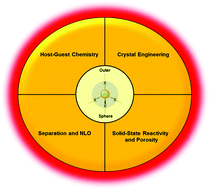Second sphere coordination of hybrid metal–organic materials: solid state reactivity
Abstract
When compared to other hybrid metal organic materials such as metal–organic frameworks, hydrogen bonded materials self-assembled by metals and organic molecules using second sphere interactions have been poorly investigated. Consequently, their solid-sate properties are also scarce. In this perspective, earlier research mainly on host–guest chemistry and its evolution towards more extended structures by applying crystal engineering principles using second sphere coordination is described. Crystal-to-crystal guest exchange reactions, permanently porous hybrid metal organic materials, mechanochemical reactivity, thermally induced phase transformations as well as some examples of functional technological applications using second sphere adducts such as gas adsorption, separation and non-linear optical phenomena are also reported. Although some tutorial reviews on second sphere adducts have been conducted mainly in the solution state focusing on metal based anion receptors, to the best of our knowledge, an overview on relevant works that focus on the solid-state properties has not been carried out. The aim of this article is to highlight from some of the early fundamental work to the latest reports on hybrid metal–organic materials self-assembled via second sphere interactions with a focus on solid-state chemistry.


 Please wait while we load your content...
Please wait while we load your content...